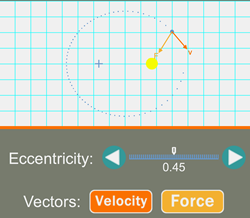 Orbital Motion
Orbital Motion
Resource:
Orbital Motion Interactive
Orbital Motion - Student Exercise
Grade Level: High School
Description:
In this simple model, students investigate the nature of elliptical orbits. They interactively explore the elliptical motion of a satellite around a central body, focusing on how the speed and the force varies with location within the orbit. Learners can change the eccentricity and see how this value changes the shape of the ellipse. The companion exercise will elicit reasoning about relationships among the shape of the ellipse, the velocity of the orbiting object, and the magnitude of the gravitational force.
Performance Expectation:
HS-ESS1-4 Use mathematical or computational representations to predict the motion of orbiting objects in the solar system.
This activity aligns with the three dimensions of the Next Generation Science Standards in the manner described below:
| Earth and the Solar System (HS-ESS1.B.1): Kepler’s Laws describe common features of the motions of orbiting objects, including their elliptical paths around the sun. Orbits may change due to the gravitational effects from, or collisions with, other objects in the solar system. |
Students interactively explore the elliptical motion of a satellite around a central body. Velocity and force vectors are displayed to show how the planet’s position in its elliptical path affects the gravitational force. The exercise will help students make connections about relationships among the shape of the ellipse, the velocity of the orbiting object, and the magnitude of the gravitational force. |
| Systems and System Models: When investigating or describing a system, the boundaries and initial conditions of the system need to be defined and their inputs and outputs analyzed and described using models |
In this activity, students expressly define initial conditions by setting the eccentricity for the orbiting object. Set it at zero and the orbital motion will be exactly circular. As the eccentricity value is continuously changed upward, the model provides outputs in three ways: velocity vectors, force vectors (showing magnitude of the gravitational force), and a tracing of the elliptical path. |
| Constructing Explanations: Apply scientific principles and evidence to provide an explanation of phenomena. |
In the supplementary Student Exercise, students have the task of describing how eccentricity of an orbit affects the elliptical nature of the orbital path. They will also describe the particular condition that must occur for the orbital pathway to be circular.
|
Associated Reading from The Physics Classroom
Other Supporting Pages at The Physics Classroom:
View
Infographic.
Search the NGSS Corner
Maybe you're looking for something really specific that pertains to a desired topic and emphasizes one or more of the listed NGSS dimensions. Why not try a search of this section of our website? Simply select from one or more of the pull-down menus and click Search. This page will reload and a collection of possibilities will be displayed in this section of the page and sorted by relevancy.